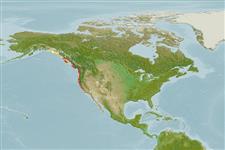>
Osmeriformes (Freshwater smelts) >
Osmeridae (Smelts)
Etymology: starksi: Named after E.C. Starks, U.S. ichthyologist (Ref. 6885).
Environment: milieu / climate zone / depth range / distribution range
Ökologie
seewasser benthopelagisch; tiefenbereich ? - 128 m (Ref. 96339). Temperate; 60°N - 34°N, 144°W - 120°W
Northeast Pacific: southeastern Alaska to Point Arguello in central California, USA.
Size / Gewicht / Alter
Maturity: Lm ? range ? - ? cm
Max length : 23.0 cm TL Männchen/unbestimmt; (Ref. 2850); max. veröff. Alter: 3.00 Jahre (Ref. 56049)
Kurzbeschreibung
Morphologie | Morphometrie
Rückenflossenstacheln (insgesamt): 0; Rückenflossenweichstrahlen (insgesamt): 8-10; Afterflossenstacheln 0; Afterflossenweichstrahlen: 15 - 19; Wirbelzahl: 60 - 64. In males, pectoral fins longer; tuberculate on head, scales, and lower fins (Ref. 6885). Green with silvery sides (Ref. 6885).
Feeds on small shrimp-like crustaceans (Ref. 4563). Caught during the spawning season (Ref. 2850).
Life cycle and mating behavior
Geschlechtsreife | Fortpflanzung | Ablaichen | Eier | Fecundity | Larven
Oviparous (Ref. 35792). Spawns in the surf at night (Ref. 2850).
Eschmeyer, W.N., E.S. Herald and H. Hammann, 1983. A field guide to Pacific coast fishes of North America. Boston (MA, USA): Houghton Mifflin Company. xii+336 p. (Ref. 2850)
IUCN Rote Liste Status (Ref. 130435)
Bedrohung für Menschen
Harmless
Nutzung durch Menschen
Fischereien: kommerziell; Sportfisch: ja
Mehr Information
Alter/GrößeWachstumLänge-GewichtLänge-LängeLängenhäufigkeitenMorphometrieMorphologieLarvenLarven Pop.Dyn.RekrutierungDichteBRUVS
ReferenzenAquakulturAquakultur ProfilZuchtlinienGenetikElectrophoresesVererbbarkeitKrankheitenVerarbeitungNutrientsMass conversion
PartnerBilderStamps, Coins Misc.LauteCiguateraGeschwindigkeitSchwimmstilKiemenoberflächeOtolithsGehirngrößeSehfähigkeit
Tools
Zusatzinformationen
Download XML
Internet Quellen
Estimates based on models
Preferred temperature (Ref.
123201): 8.3 - 12.4, mean 9.7 °C (based on 72 cells).
Phylogenetic diversity index (Ref.
82804): PD
50 = 0.6250 [Uniqueness, from 0.5 = low to 2.0 = high].
Bayesian length-weight: a=0.00372 (0.00182 - 0.00758), b=3.17 (2.99 - 3.35), in cm total length, based on LWR estimates for this (Sub)family-body shape (Ref.
93245).
Trophic level (Ref.
69278): 3.5 ±0.50 se; based on food items.
Widerstandsfähigkeit (Ref.
120179): hoch, Verdopplung der Population dauert weniger als 15 Monate. (tmax=3).
Fishing Vulnerability (Ref.
59153): Low vulnerability (13 of 100).
